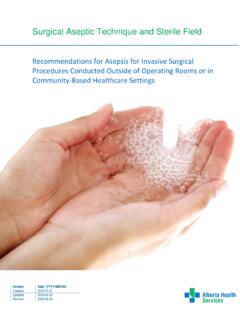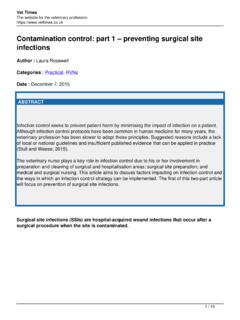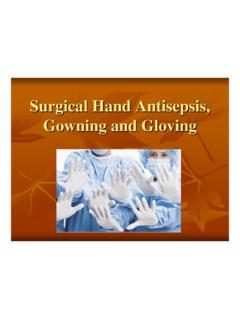Transcription of ANSI/AAMI ST79: 2017 Comprehensive guide to steam ...
1 ANSI/AAMI st79 : 2017 Comprehensive guide to steam sterilization and sterility assurance in health care facilities Suzanne Latta, CSPDT Education Materials Coordinator This is an update of the ANSI/AAMI st79 Comprehensive guide to steam sterilization and sterility assurance in health care facilities that use steam sterilizers and a go to guide in healthcare facilities. Sterilization and cleaning in the sterile and decontamination rooms comes with training and education for the staff to properly utilize the equipment to prevent potential health hazards to the employees and patients.
2 There are several areas to be conscious of when cleaning the instruments and assembling them on the clean side: the shoes you wear, proper PPE, knowing what to wear underneath your PPE to keep cool, humidity and temperature. This also includes implements that are used to effectively clean the instruments and the proper way to unload sterile packages and rigid containers from the loading cart. Other areas to consider are how sterile packages are stored after sterilization and transporting sterile items and containers to the sterile storage area without damaging or contaminating them.
3 These are standard practices that should be adhered to, to omit potential hazards. Decontamination While working in the decontamination room, stay cool and dry as much as possible. Temperature and humidity rises as you are working with no air circulation throughout the decontamination room with a heavy workload, so there should be short periods of work with rest periods in between. Healthmark has designed cool aids to provide more comfortability while working in the decontamination room. Some examples include wearing cooling devices such as a bandana to keep the forehead cool or skull cap or towel around the neck to stay dry and not overheated.
4 When donning PPE, gloves are just as important, so your hands do not encounter contaminated water and instruments. Section Decontamination area/room states, Utility gloves that are fitted at the wrist, prevent contact of the wearer s skin with contaminated water, and have cuffs that extend beyond the cuff of the gown. This will prevent contaminated water from reaching underneath the gloves and encountering the skin. Healthmark offers several different types of decontamination gloves to help protect against contaminating the skin: The Sleeve Glove that reaches 12 inches in length and overall 28 inches reaching to the upper arm.
5 The Chemotherapy Rated Glove is thick and tough enough to use in decontamination room. A face shield is another important factor in PPE. It blocks splash up from the water in the sink and protects the entire face and neck from encountering contaminated water and reduces the risk of eye injury from hazardous chemicals agents.
6 (Section ) Healthmark offer: A Face Shield (18000-100) - with a neck guard attached to protect face and neck from bloodborne pathogens. Shoes worn in the decontamination room should be clean with a closed toe and closed heel to protect the feet from contaminated water and prevent injury to the feet if items are dropped. Presoaking instruments prior to being cleaned should have a moist towel covering the instruments or place objects or instrument sets in a moist pack to avoid drying of tissue and gross soil from drying on the object until it reaches the decontamination room for reprocessing.
7 Section Prevention of instrument damage talks about keeping instruments moist such as placing items inside a package designed to maintain humid conditions. Healthmark offer: Humipak (HPSS2035, HPSS4243, HPSS4267, HPSS6577) - has a highly absorbent material placed in between two layers of waterproof film that keeps the items moist until they are ready to be reprocessed. Handling and Collection of Contaminated Items Single-use items are separated from reusable items prior to being delivered to the decontam room.
8 Reusable items that are contaminated are placed in a bin with a lid and a red biohazard sticker to identify that it is dirty. Section Separation of waste and reusable items at point of use states, Contaminated reusable items should be contained: in such a way that the contents of the container are readily identifiable as contaminated by everyone who subsequently handles the items. Healthmark offer: SST- 2315 - contains a base tray and is large enough to hold a complete set of instruments. It has a snap down lid and mold -in gasket to provide a near watertight seal.
9 SST-2136 GSK - is a full-size system which is ideal retrieval for , instruments and high volume s. SST-283 - is a midsize system for minor procedures including retrieval for and sets. Steristrainer is autoclavable as well and latches are optional. Brushes The implements used in the decontamination room are just as important when cleaning instruments.
10 Using the correct size brushes on medical devices will ensure adequate cleaning the first time; this will eliminate re-cleaning if found to be dirty on the clean side and will also eliminate possible contamination of other instruments. It is important to read the manufacturer s IFU to determine which size brush(s) is used for that device. In section Manual Cleaning it states, Clean lumened devices with a brush of the recommended type, size (diameter and length), and bristle type. Also, If the device manufacturer specifies a specific brush or cleaning implement, the brush or an equivalent should be used.



